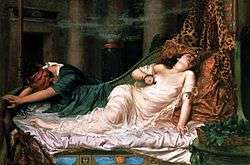Antony and Cleopatra (1959 film)
Antony and Cleopatra is a 1959 Australian television play based on the play by William Shakespeare.[2] Australian TV drama was relatively rare at the time.[3]
| Antony and Cleopatra | |
|---|---|
| Based on | play by William Shakespeare |
| Written by | Arthur Chipper |
| Directed by | Christopher Muir |
| Country of origin | Australia |
| Original language(s) | English |
| Production | |
| Running time | 125 mins |
| Production company(s) | ABC |
| Distributor | ABC |
| Release | |
| Original network | ABC |
| Original release | 17 June 1959 (Melbourne) (live)[1] 8 July 1959 (Sydney, taped) |
It was broadcast live in Melbourne then recorded and screened in Sydney. The ABC also broadcast a production of Hamlet at the same time, which was broadcast live in Sydney then recorded and screened in Melbourne.[4] Australian TV drama was relatively rare at the time.[3]
Cast
- Bettie Kauffman as Cleopatra
- Keith Eden as Antony
- Kevin Miles as Caesar
- Laurier Lange as Lepidus
- Edward Howell as Agrippa
- Judith Godden as Charmain
- Paul Bacon as Alexas
- Beverly Dunn as Octavia
- Frank Gatliff as Pompey
- John Morgan as Menas
- Keith Hudson as Eros
- Alan Tobin as Procuecius
- Colin Eaton as Soothsayer
- Philip Stainton as Clown
- Hugh McDermott as first messenger
- George Ogilvie as second messenger
- Alan Hopgood as first soldier
- Alan Morley as second soldier
- Ken Goodlet as Enobarus
- Soula Paulay, R de Winter, Antonio Rodrigues and Albert la Guerre as Cleopatra's attendants
- Nevil Thurgood, John Godfrey and Peter Diess as soldiers
Production
Arthur Chipper did the adaptation, which made a number of alterations from the play, including reducing the characters and opening it in Rome not Alexandria.[5]
It was shot at ABC's studios in Rippon Lea. There were 15 speaking parts and six extras. The set was designed by Jon Peters. It was Keith Eden's first performance as a "straight" actor on TV - he was better known as a radio actor.[1] There were 31 scene changes.[6] Keith Clarke did costumes.[7]
Reception
The critic for The Age thought the play was "not for television."[8] Another critic for the same paper said it "was a gallant and praiseworthy attempt in the face of heavy odds" but did not think the play suitable for television although he liked the two lead performances.[9]
The Sydney Morning Herald critic wrote that:
Not much of the pomp and poetry came through the rich texture of Shakespeare's language in the... production.. although as a straightforward account of love and war this Melbourne performance Was satisfactory enough. Two things helped to lower the temperature of the love and the language; first, Arthur Chipper's rearrangement of the first half of the play was quite skillful, but the cutting was on a political rather than on a passionate bias, and second, producer Christopher Muir'_s use of cameras and- lighting did little—except in a few scenes — to imaginatively underline the play's mood, atmosphere, and growing tensions.[10]
The Bulletin also gave it a bad review.[11]
See also
- List of live television plays broadcast on Australian Broadcasting Corporation (1950s)
References
- "Shakespeare Dramas ABC TV Project". The Age. 23 April 1959. p. 12.
- "A BIG NEW DEAL FOR COLOR TV". The Australian Women's Weekly. 27 (7). 22 July 1959. p. 50. Retrieved 21 May 2016 – via National Library of Australia.
- Vagg, Stephen (18 February 2019). "60 Australian TV Plays of the 1950s & '60s". Filmink.
- "Two Productions of Shakespeare". Sydney Morning Herald. 15 June 1959. p. 17.
- "Second Presentation of Shakespeare". Sydney Morning Herald. 6 June 1959. p. 13.
- "Shakespeare Test for TV Techniques". The Age. 11 June 1959. p. 12.
- "Producer Checks Costumes". The Age. 11 June 1959. p. 14.
- Janus (25 June 1959). "Shakespeare Not for Television". The Age. p. 14.
- "Shakespeare in "Live" TV Shows". The Age. 18 June 1959. p. 3.
- "Live Antony and Cleopatra on TV". Sydney Morning Herald. 9 July 1959. p. 6.
- The bulletin, John Haynes and J.F. Archibald, 1880, retrieved 23 March 2019
